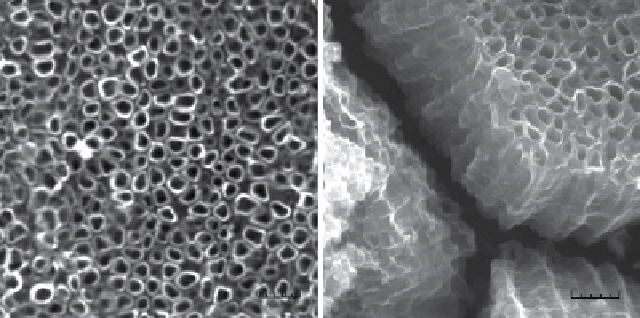Environmental Engineering Reference
In-Depth Information
In a very interesting synergistic approach, Wu et al. developed and tested a metal-/nonmetal-doped TiO
2
catalyst for the inac-
tivation of Gram-negative (
E. coli
and
P. aeruginosa
) and Gram-positive (
S. aureus
) cells [69]. They found that by combining
both metal and nonmetal dopants, PC activity was much higher than using the dopants separately under visible light
illumination.
2.5
slurries or iMMobilized Photocatalyst
The generation of catalyst sludges as by-products is one of the main disadvantages of HP processes in water treatment. At the
pilot-plant level, HP uses suspended TiO
2
in photoreactors where the semiconductor is recovered after the treatment. According
to various lab-scale research reports [14]
,
the use of TiO
2
in suspensions is more efficient than their use in immobilized forms.
Nevertheless, this latter form possesses specific advantages, such as cost reductions, a decrease in material losses, and the
likelihood of skipping recovery steps in the process, which make it possible to produce immobilized titania photocatalysts with
higher efficiency as compared with those reported to date [70, 71]
.
several supporting materials, from sand to quartz optical fiber, have been reported so far for TiO
2
immobilization. During
the past few years, the in situ generation of catalysts seems to be the most promising technology for catalyst immobilization
[71]
.
Other authors [72] have demonstrated that by using this method, the generated fixed form of titanium dioxide presents
equal efficiency as Degussa P-25 (considered the most efficient form of titanium dioxide) suspended catalyst for bacteria inac-
tivation. However, more research is needed before this can be considered for the future design of efficient PC processes.
2.6
tio
2
Particles aNd NaNotubes
Nanostructured TiO
2
with different sizes, shapes, and morphologies (nanoparticles, nanofibers, nanowires, nanorods, nano-
porous materials, and nanotubes) have been prepared and their unique properties tested for several applications [73]
.
The
preparation method plays a key role on the variety of structures formed. some well-known methods to prepare TiO
2
nano-
structures are sol-gel, microemulsion, hydrothermal, solvothermal, vapor deposition, and anodization [74, 75]
.
The main idea
behind this molecular design is to improve the physical and chemical properties of TiO
2
, including their PC activity and PV
response [76]
.
One of the most promising TiO
2
nanostructures for environmental applications is titanium dioxide nanotubes (TDN).
Literature on TDN is the second most abundant only after that on carbon nanotubes. TDNs prepared from the anodization of
metal plates have attracted interest because they can improve performance on well-known titania applications such as water
photoelectrolysis, photocatalysis, heterojunction solar cells, gas sensing, and environmental purification [77, 78] since they
provide a highly ordered TiO
2
nanotubular array with a large specific surface area. Two important structural characteristics of
these TDN arrays are their inner diameter of approximately 100 nm and an average length of 3 μm (fig. 2.2).
The highly ordered structure can improve the transport of photogenerated electrons in the TiO
2
film by providing a
unidirectional electric channel and reducing grain boundaries in photocatalysis and photoelectrochemical applications, while
the large surface area can allow more efficient light harvesting [79, 80]
.
500 nm
500 nm
figure 2.2
standard electron microscope (sEM) images of TDN obtained by anodization. Left top view; right cross-sectional image.

